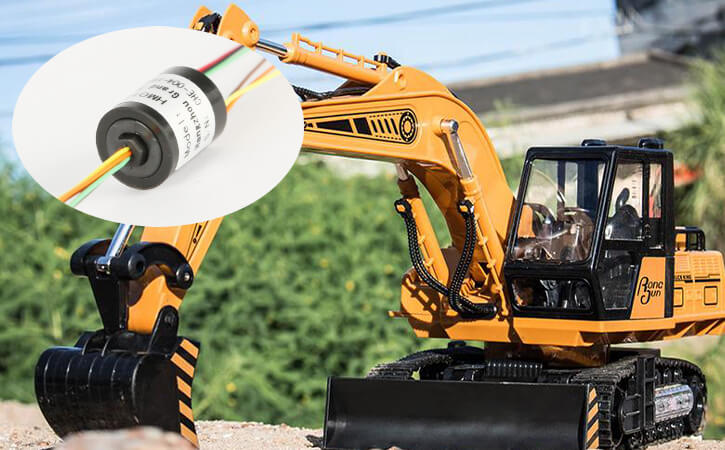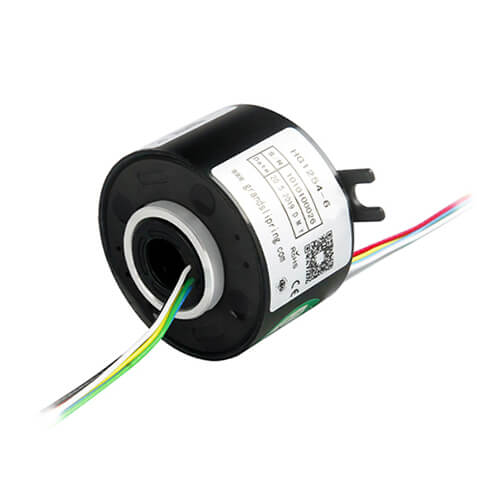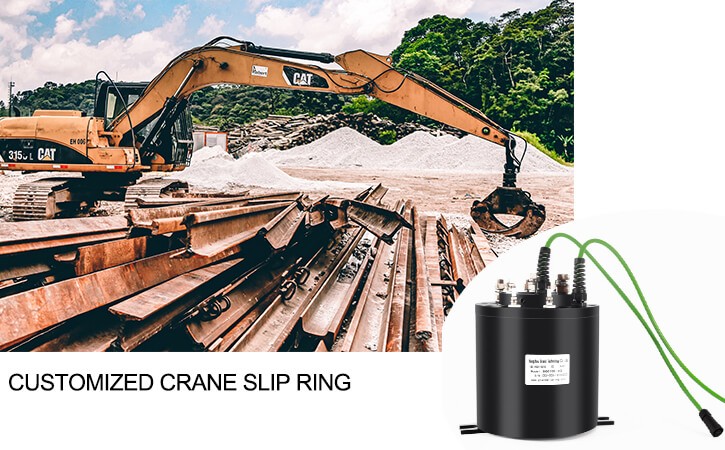In this article, we delve into the world of slip rings and their critical role in crane operations. We explore their mechanics, types, benefits, design considerations, and how to troubleshoot related issues. Additionally, we’ll glance towards the horizon to predict what future innovations might bring to this industry.
Introduction to Slip Ring Applications in Cranes
Technology is at the heart of most of our modern world’s mechanical operations, with a multitude of devices and components working seamlessly together to create efficient and effective systems. Among those components, slip rings play a central role, forming the cornerstone of many mechanized operations.
Predominantly used in electromechanical systems that require constant rotation while transmitting power or data, slip rings serve as a bridge between the stationary and rotating parts of a machine. They ensure an uninterrupted electrical connection, irrespective of the rotational activities the machine partakes in. Unsurprisingly, the application of slip rings extends to multiple sectors including wind turbines, medical imaging devices, radar systems, and the focus of this article, cranes.
In the context of cranes, which serve as the pillars of construction and heavy machinery industries, slip rings warrant special mention. Cranes, especially those that rely heavily on extensive 360-degree rotation, need a robust and reliable solution to maintain power or signal transmission without any glitches – precisely the function slip rings excel at. The way these rings are integrated with a crane’s system directly influences the machine’s reliability, lifespan, and overall efficiency.
In this article, we will embark on a journey to explore the world of slip rings and their significance in crane operations. We’ll delve into their operational basics, scrutinize different types of slip rings and their specific uses in cranes, understand the benefits they offer, discuss the vital aspects of designing and manufacturing these components, and tap into their maintenance and troubleshooting aspects. Lastly, we’ll glance into the crystal ball to predict upcoming developments and trends shaping the future of slip ring technology in cranes.

Basics of Slip Rings and Their Significance in Cranes
To fully understand the impact of slip rings on the performance of cranes, we first need to comprehend their working principle and the role they serve within these heavy-duty machines.
Working Principle of Slip Rings
A slip ring is an electromechanical component that facilitates the transfer of electrical power or signals from a stationary structure to a rotating component in a machine. The device typically consists of a conductive ring and brushes, which maintain contact even as the connected machinery rotates. The conductive ring, situated on the rotating part, achieves a continuous electrical connection through the brushes that slide along its surface. As the rotating component spins, the brushes remain in contact with the ring, ensuring an uninterrupted power or signal transfer.
Continuous Electrical Connection Amid Rotational Movements
The key function that slip rings perform is maintaining a continuous electrical connection in the face of rotational movements. Rotational motion, by its very nature, can pose challenges to power and signal transmission. Slip rings address this issue effectively, preventing any distortion in signals or disruption in the electrical power supply. This vital role is what makes slip rings invaluable for machines that rely on consistent and steady power sources during their operations.
Criticality of Slip Rings in Cranes
Cranes form an essential part of industries where the lifting, moving, and precise positioning of heavy loads and materials are required. For many cranes, 360-degree rotation is fundamental to their operations, enabling them to transport these hefty payloads across broad workspaces. Strong and reliable power and signal transmissions are necessary to keep these machines operating safely and effectively – any disruptions to their electrical supply can result in serious consequences, including work delays or even accidents.
That’s where slip rings come into play. By ensuring a steady electrical connection during a crane’s constant rotational movements, slip rings allow these machines to operate efficiently, minimizing any potential downtime due to electrical issues. Moreover, the smooth transmission channel they provide also allows for precise control and maneuvering, which are integral to the crane’s functionality.
In essence, slip rings are indispensable to cranes, empowering these machines to lift, rotate, and position heavy components effortlessly – no matter the extent of their rotations. This unwavering electrical connection is what enables cranes to work seamlessly and safely, day in and day out.
Different Types of Slip Rings Used in Cranes
Just as there is a plethora of cranes tailored to perform various tasks, so is there a variety of slip rings designed to accommodate the different needs of each type of crane. These slip rings, each with their unique design and traits, are nuanced to perfectly match the requirements of the specific crane they’re paired with.
An Exploration of Slip Ring Types
Pancake Slip Rings
Known for their disc-like structure, hence the name ‘pancake’ slip rings, these types of slip rings are perfect for cranes where vertical space is limited. Unlike cylindrical variants, the pancake slip rings’ flat profile allows them to fit into tight spaces where height is a constraint. However, due to the tangential speed limitations and increased brush wear of this design, they are generally used in slow-speed applications.

Through-hole Slip Rings
Through-hole, or hollow shaft slip rings, are named for their characteristic ‘hole’ in the center. This central void allows them to be placed over a rotating shaft, or even to accommodate additional equipment like fiber optic rotary joints. Through-hole slip rings are often found on cranes to accommodate their high rotational speed and power signal transmission. Furthermore, they can be designed to fit various sizes of rotating objects, making them a flexible and versatile solution.

Applications and Advantages of Slip Ring Types in Cranes
Each of the aforementioned slip rings brings significant advantages to crane operations:
Pancake Slip Rings in Cranes
Despite their usually slow speed, pancake slip rings are invaluable in situations where a crane must fit into a confined vertical space. They effectively compact the high power and myriad of circuit signals needed, enhancing the performance of the crane in its limited environment.
Through-hole Slip Rings in Cranes
Through-hole slip rings’ value comes in their versatility and adaptability. They can be tailored to allow for varying bundle sizes through the central hole, making them ideal for different crane types and catering to their unique rotational needs. Equally important, they can support higher rotating speeds compared to their pancake counterparts, making them well-suited for cranes that need seamless, fast-paced rotation and power transmission.
In a nutshell, slip rings’ adaptable nature makes them a pivotal component in cranes. Regardless of the type of crane or the space limitations it might face, there is always a slip ring solution available to ensure smooth, uninterrupted electrical current flow, guaranteeing that cranes can perform their task efficiently and without delay.
Benefits of Slip Rings in Cranes
Integrating slip rings into a crane’s design offers several tangible benefits – from marked improvements in efficiency to avoiding hazardous situations like cable twisting. Below, we delve into some of these key benefits and illustrate them with real-world examples where slip ring technology has transformed crane operations.
Efficiency Improvement
Scaling the heights of efficiency is facilitated by the introduction of slip rings in cranes. Slip rings allow for flawless power transmission, even in the face of perpetual rotation. This constant supply of power ensures crane motors perform optimally at all times, thereby enhancing the machine’s efficiency.
For example, a crane engaged in loading and unloading heavy goods at a port is constantly revolving to fetch from and deliver to different spots. A slip ring, by offering a steady power supply during these constant rotations, ensures operations proceed without a hitch, thereby enhancing productivity and operational efficiency.
Prevention of Cable Twisting
Cable twisting is a common problem faced in heavy machinery, particularly when rotation is involved. If not addressed, it can lead to cable breakages, electrical arcing, signal interference, and even safety incidents.
Slip rings present a reliable solution to prevent cable twisting. Because of their ability to transfer power and signals between stationary and rotating components in a machine, they automatically eliminate the issue of cable twisting in cranes.
Consider a tower crane on a construction site which often rotates at 360 degrees. Intricate cabling is involved to ensure the electrical connection between the stationary part and the rotating part of the crane. Without a slip ring, repeated rotations might twist and stress the cables, gradually leading to their failure.
By integrating a slip ring, there’s no need for lengthy, tension-prone cables. The slip ring, affixed to the base of the crane, lets the crane rotate without twisting the cables, thus preserving their integrity while ensuring uninterrupted operations.
Real-world Applications Showcasing the Importance of Slip Rings in Cranes
A stark demonstration of slip ring technology enhancing crane operation can be found in the offshore industry’s cranes. Offshore operations require cranes to work in a harsh, corrosive sea atmosphere under brutal weather conditions.
For instance, the application of specially designed slip rings in offshore pedestal cranes not only guarantees consistent power transmission and data communication but also withstands challenging weather and working conditions.
Moreover, these slip rings come with integrated fiber optic rotary joints to enable real-time data and video transmission. This allows for safer, more controlled operations, which are paramount in such high-risk environments.
In a nutshell, the seamless efficiency, increased safety, and enhanced control facilitated by slip rings underscore their instrumental role in the up-gradation of crane operations, be it in a construction yard, a bustling port, or the demanding offshore field.
Design and Manufacturing Considerations for Crane Slip Rings
The design and manufacturing of slip rings for cranes call for a careful analysis of several pertinent factors. These factors drive the requirements of the slip ring’s specifications and guide its integration within the crane system. From the crane’s operating conditions to the weight it has to handle—each parameter influences the slip ring’s final design.
Considerations of Crane’s Operating Conditions
A crane’s operating conditions dictate key features of a suitable slip ring. Its working environment, exposure to elements, and anticipated loads directly influence specifications like the number of circuits, voltage, and current requirements.
For instance, a crane operating in a marine setting may contend with high levels of humidity and corrosive saltwater. In such cases, the slip ring must be constructed from materials that can resist corrosion and continue to function reliably under such conditions.
Similarly, a crane operating in a hazardous or flammable environment necessitates a slip ring manufactured from non-sparking materials with specific certifications to guarantee safety.
Furthermore, a crane designed to handle substantial loads at high heights requires a slip ring capable of carrying heavy currents without overheating or degrading, ensuring the crane’s lifting function remains uncompromised.
Influencing Factors on Circuits, Voltage, and Current Requirements
The number of circuits in a slip ring is determined based on the functions that the crane needs to perform. If it’s a sophisticated, high-tech crane featuring multiple controls and communication functions, the slip ring may need numerous circuits to cater to these separate channels.
Additionally, the weight that a crane must lift is an important factor influencing the voltage and current requirements. Higher lifting capacity involves a greater torque on the crane’s motor, which consequently demands a higher voltage for the efficient functioning of the motor. Therefore, the slip ring must be designed to efficiently handle these higher voltages and currents.
Importance of Choosing the Right Slip Ring
With so many factors to consider, it becomes clear that selecting the right slip ring for a specific crane model and environment is crucial. The wrong choice could lead to subpar performance, machine downtime, or even catastrophic failure of the crane.
For example, selecting a slip ring with insufficient voltage capacity for a crane tasked with lifting heavy pipes in an oil and gas refinery could result in a power delivery shortfall. This could not only slow down operations but also pose a significant safety risk due to the potential dropping of loads.
Similarly, a slip ring not specifically designed for a marine environment, when employed in a dockside crane, might quickly succumb to the corrosive effects of saltwater. This corrosion could interrupt the power supply, causing a sudden halt in operations and expensive repair or replacement costs.
In summary, the design and manufacturing considerations for crane slip rings are multifaceted, particularly as they have to account for a host of factors specific to each crane model and the environment in which they operate. Remember, the more accurate the slip ring is in meeting these considerations, the more reliable and efficient the crane will be in performing its duty.
Maintenance and Troubleshooting of Slip Rings in Cranes
Maintaining and troubleshooting slip rings in cranes is a vital aspect of machinery upkeep. Overlooking this process can result in quicker deterioration of parts, decreased performance, and a short lifespan. However, with regular checks and swift addressing of common issues, the longevity and efficiency of both the slip ring and the crane can be ensured.
Importance of Regular Maintenance
Regular maintenance of slip rings greatly contributes to enhancing their lifespan and ensuring their consistent performance. The electrical contacts within slip rings are subject to wear and tear, especially in high-duty applications like cranes. Over time, without proper maintenance, this can lead to the degradation of the electrical connection, resulting in power interruptions or signal loss.
Scheduled checks allow early identification of problems before they escalate. The process typically includes cleaning the slip rings and brushes, examining for wear and tear symptoms, and replacing components as necessary.
For an example of the practical benefits, a dock crane equipped with regularly maintained slip rings can contribute to smooth port operations by avoiding unexpected downtime and associated costs.
Common Issues and Troubleshooting Tips
Despite regular maintenance, slip rings in cranes might occasionally face issues that hamper their performance. Understanding these common problems and knowing how to identify and troubleshoot them are crucial skills for the crane operators and maintenance crew.
- Excessive Wear: This is usually caused by poor alignment or incorrect pressure between the brush and the slip ring, leading to increased friction and hence, wear. Regular checkups can identify this issue at an early stage. Refitting and adjusting the brush system can alleviate the problem.
- Voltage Drop or Intermittent Signals: This might be the result of a dirty or degraded contact surface. Maintenance should include thorough cleaning to ensure an optimal connection.
- Overheating: This often results from overload or excess current being transmitted via the slip ring. Ensuring the load remains within the slip ring’s specifications can prevent such issues.
- Noise or Vibration: Misalignment or imbalances in the brush or slip ring can create noise or vibrations. Proper alignment and ensuring that the system’s mounting is secure will resolve this issue.
Overall, recognizing slip rings as a crucial component in crane operation and giving them the regular maintenance and swift troubleshooting they deserve significantly extends their lifespan and the reliable performance of the crane itself. This simple yet crucial process contributes to safer, more efficient operations, reducing the likelihood of unforeseen breakdowns and costly downtime.
New Developments and Future Trends in Crane Slip Ring Technology
As technology progresses, so does the design and function of slip rings for cranes. From the coalescence of wireless technologies to the integration of smart systems, the slip ring technology is undergoing significant transformation, hinting at exciting prospects for further enhancements in crane operation and maintenance.
Ongoing Trends: The Shift Towards Contactless Slip Rings
Among the noticeable trends, the shift towards contactless slip rings or ‘through-air’ slip rings is gaining traction. Traditional slip rings rely on physical contact between the brushes and the ring, which can lead to wear and tear, friction, noise, and a limit on rotational speed.
However, contactless slip rings eliminate these constraints. They rely on magnetic fields or other means to transmit data and power, thus reducing physical wear and permitting higher rotational speeds. In a practical scenario, an overhead crane fitted with contactless slip rings would operate more quietly, efficiently, and with fewer maintenance requirements than a similar crane equipped with traditional brush-contact slip rings.
Possible Future Developments
In terms of future developments, the integration of smart technologies in slip rings holds great promise. By incorporating sensors and other intelligent systems, slip rings could monitor their performance, identify maintenance needs in advance, and even remotely report these conditions to operators, thus reducing unexpected machine downtime.
Moreover, there’s interest in developing energy-efficient or green slip ring tech. With the growing emphasis on sustainability and energy conservation, this could involve designing slip rings capable of energy recovery during crane operations.
Potential Effects on Crane Operation and Maintenance
These advancements and potential innovations bear exciting implications for the future of crane operations and maintenance. Contactless technology and smart monitoring systems can simplify routine maintenance, reduce machine downtime, and drastically cut operation costs.
For instance, improvements like contactless operation would mean fewer parts replaced during routine overhauls of slip ring systems, and sensor-imbued systems could warn operators before any potential failure.
Meanwhile, energy-efficient slip ring designs could lower the carbon footprint of crane operations, simultaneously contributing to energy-saving and environmental sustainability goals – inherently a win-win scenario.
In conclusion, contemporary trends and potential advancements in slip ring technology mirror the wider evolution in industrial machinery – towards increased efficiency, longer lifespans, reduced maintenance, and greater automation. With these innovations in place, the future of crane operation and maintenance is poised to be more reliable, efficient, and eco-friendly than ever before.
Conclusion
Slip rings’ importance in crane operations cannot be overstated. From improving operational efficiency to paving the way for future crane innovations, slip rings are at the heart of the technology making cranes safer, more productive, and more reliable. As technology evolves, it will be intriguing to watch how these trends shape the cranes of tomorrow.
See What We Can Do

